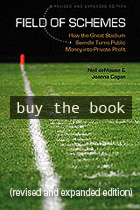This is an archived version of a Field of Schemes article. Comments on this page are closed. To find the current version of the article with updated comments, click here.
August 13, 2005
A's stadium plans unveiled (sort of)
Oakland A's owner (and L.A. real-estate magnate) Lew Wolff issued his long-awaited proposal for a new stadium yesterday, and they're, uh, interesting. Condos in center field. A tiny 35,000-seat capacity, to help create artificial ticket scarcity. A triangular bleacher section designed to be vaguely reminiscent of Fenway. And presumably plenty of other quirks, though they're hard to make out on the team's renderings, which look as if they were designed on a Playstation.
And just who would pay for the stadium, which would sit on a large plot of land just north of the A's current home? Wolff said the team would pay for "the vast majority" of stadium construction costs, and that he wouldn't ask the government to sell bonds for the project... and that's pretty much all he said. The A's p.r. flacks denied all knowledge of project details aside from a mealy-mouthed Wolff press release (sample English-like text: "A visionary leadership from all parties associated with this project who believe the A's are a community asset is required to help us reach our objective in creating one of the most exciting venues in all of sports"), meaning that questions about the project - who will pay to buy the land from its current private owners, will Wolff seek property-tax breaks or other tax incentives, and if the team would pay the "majority" of construction costs, who would pay the rest? - remain unanswered. For now, the would-be A's ballpark is all pretty pictures and hand-waving - and with Wolff insisting he won't "negotiate through the media," it could be a while before the public is let in on just what they'd be expected to contribute here.
What the A's plans do make clear is that we've entered a new era in baseball stadium construction. Wolff's plan bears all the hallmarks of what is becoming the 21st-century standard for ballpark seekers everywhere:
- Hide the subsidies. Taxpayers hate spending public money on stadiums, so offer to pay the full load, or at least most of it. They tend to get less uppity, though, if instead of cash you want tax breaks - even though economists consider them "tax expenditures" that have an identical effect on the public purse - so frame your subsidy requests as breaks on property taxes, sales taxes, rent, etc. If you play your cards right, this can amount to hundreds of millions of dollars, and you can still claim to be building a "privately funded" ballpark!
- Throw in the kitchen sink. Taxpayers also hate funding sports-only projects, but if it's a "ballpark village" with housing and retail space, well, that's a fuzzier issue. Attach a bunch of other development to your stadium plans, and you can hopefully muddy the waters enough that no one can understand the finances, even if you're asking for 60 acres of free land.
- Take the revenue-sharing money. Contrary to popular belief, even low-revenue teams like the A's can take advantage of baseball's new revenue-sharing deduction for stadium costs - no matter where you fall on baseball economic scale, the deduction saves you about 40% on your construction and operations expenses. This is by far the main reason why we're seeing teams like the Cardinals, Yankees and Mets offer to pay substantial shares of stadium costs (the Twins apparently didn't get the memo) - as with the NFL's G-3 stadium loan program, private funding suddenly looks a whole lot more alluring when you're getting a hefty subsidy from the league.
So is the A's deal a good one for the city of Oakland, for taxpayers, for fans? There's simply no way to tell, not without more information that Wolff doesn't appear willing to provide at the moment. But it definitely is the wave of the future - and not just because it has outfield seats on top of a building.
Your optimism about the new stadium in Oakland is overwhelming. As for us here in town, we're quite excited about the possibilities. Why not create artificial demand? All of the new parks have some ersatz elements to them. The term "white elephant", while commonly applied to the A's, was in fact a comment made by John McGraw in reference to the upstart new American League. It is associated with the A's because the Giants were embarking on a Series with them.
Posted by Rennie Einstein on August 25, 2005 12:09 PM




